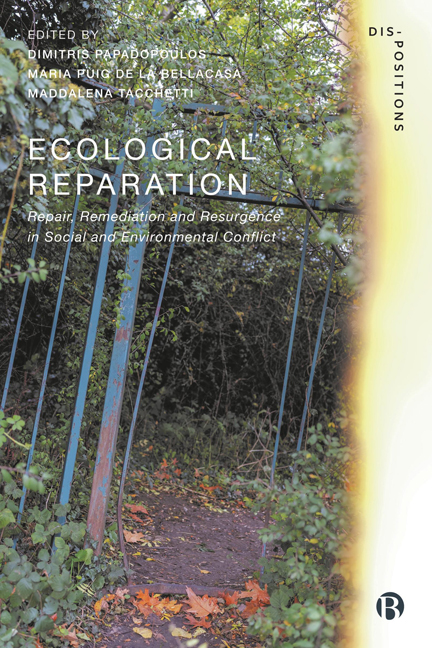Book contents
- Frontmatter
- Contents
- List of Figures
- Notes on Contributors
- Acknowledgements
- Note on the Figures
- Dis-Positions Series Preface
- Introduction: No Justice, No Ecological Peace: The Groundings of Ecological Reparation
- PART I Depletion<>Resurgence
- PART II Deskilling<>Experimenting
- PART III Contaminating<>Cohabiting
- PART IV Enclosing<>Reclaiming Land
- PART V Loss<>Recollecting
- PART VI Representing<>Self-governing
- PART VII Isolating<>Embodying
- PART VIII Growth<>Flourishing
- Index
21 - (Un)crafting Ecologies: Actions Involving Special Skills at (Un)making Things Humans with Your hands
Published online by Cambridge University Press: 28 March 2024
- Frontmatter
- Contents
- List of Figures
- Notes on Contributors
- Acknowledgements
- Note on the Figures
- Dis-Positions Series Preface
- Introduction: No Justice, No Ecological Peace: The Groundings of Ecological Reparation
- PART I Depletion<>Resurgence
- PART II Deskilling<>Experimenting
- PART III Contaminating<>Cohabiting
- PART IV Enclosing<>Reclaiming Land
- PART V Loss<>Recollecting
- PART VI Representing<>Self-governing
- PART VII Isolating<>Embodying
- PART VIII Growth<>Flourishing
- Index
Summary
Instructions to read
Dear reader:
When reading this text, I invite you to remember two things. First, if you are not familiar with weaving, I would like to show you two components of woven textiles: the warp and the weft. That is the first thing you should bear in mind.
The second is also an invitation to think of this content as a textile in four dimensions:
1. In a concrete material dimension, it is textile because it produces a textile piece.
2. It is also textile because it follows textile logics during the process of material making. The textile making process is a social practice weaving. Imagine the textile making process as the warp that gathers together and assembles, diverse species – humans and more-than-humans – as part of a textile ecology and other ecologies.
3. The text itself is an attempt to weave different voices. The narration is interweaving diverse voices as threads. You will find these voices in different styles. In these brackets [·] you will find my thoughts, my emotions, connections I make as a voice off; you can skip these parts if they get too noisy for your taste. In these brackets < ・ > and in italic you will find the participants’ voices, and in these brackets ﹛·﹜ and in bold you will find fictional voices as part of academic worlds. Along with the text, you will also find crossed-out words. I would rather keep them than erase them; if I took them out, you would not notice their absence, but their crossed-out presence will add material meaning.
4. Finally, all that is here is part of a giant fabric whose [I would say]. Its materiality is semiotically textile. As noted by John Law when explaining material semiotics, ‘practices in the social world are woven out of threads to form weaves that are simultaneously semiotic … and material’ (Law, 2007: 7).
<Look, she is Eliana> Salvador told his workmate. He had his hands on my shoulders, holding me carefully from my back, while he gazed at his friend with a look that told us all what we needed to know. A story of a year was said with a look in just a second.
- Type
- Chapter
- Information
- Ecological ReparationRepair, Remediation and Resurgence in Social and Environmental Conflict, pp. 329 - 343Publisher: Bristol University PressPrint publication year: 2023



